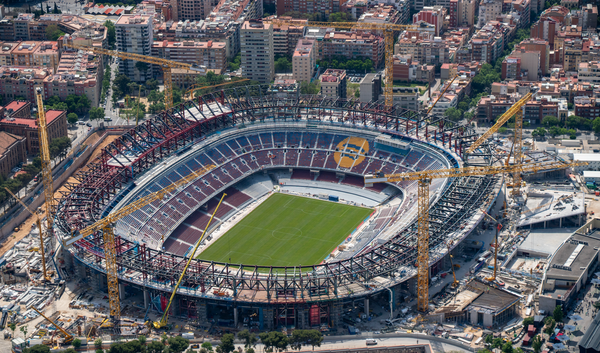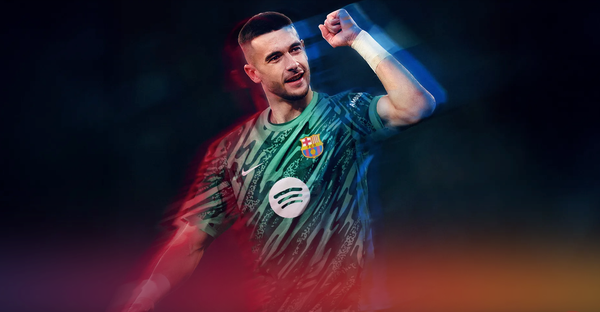Nico González & Frenkie de Jong: What makes an ideal Barcelona interior?
A Barca interior needs great spatial awareness to find pockets of space and link defence with attack.

The sudden rise of Nico González has perhaps been surprising but also nothing short of incredible. Of course, if you were following him during his LaMasia days, this may not shock you as much. After all, the young midfielder has always been a great and versatile talent within the academy.
But nowadays, that’s also no guarantee of success. The likes of Riqui Puig and Carles Aleñá among the current crop of graduates can attest to that. Still, Nico feels different in many ways. His player profile makes him stand out from the crowd despite traits akin to some of his academy peers.
Frenkie de Jong, on the other hand, comes from a similar and yet, different background. Yes, the Dutch school of football is at the very core of Barcelona but the two are still not one and the same. Frenkie, however, was dubbed as the perfect fit for the Catalan giants; an outsider with the understanding and skill of a local.
But it’s also been years since his arrival and yet, it still feels we’re waiting for him to break out of his shell. The return of Ronald Koeman, the man destined to help his compatriot reach his potential, has done little to no good for his development. When we compare that to Nico’s situation, it does pose an interesting question.
Why does there seem to be such a difference between two players who, at first glance, seem eerily similar? Why is one’s trajectory so positive while the other clearly struggles despite moments of success?
Let’s find out.
Clarity of role
I was often very vocal about positions and roles being vastly different to one another. Players can play in the same position but have completely different roles within a particular system. To a certain extent, this is the core difference between Nico and Frenkie. One is clearly defined within the constraints of his role and profile while the other exists in a perpetual limbo created by the unclarity and vastness of his responsibilities.
In other words, one has a clear function despite Barcelona’s lack of structure while the other often gets lost in it. And when we strip them of all the outside characteristics - their ability, talent, potential and understanding - we see that skill may not have as much to do with it as it seems. After all, Nico and Frenkie have a lot in common.
Both are players of great technical quality, players who love to drive forward with the ball, make off the ball movement and have the skill set of a box-to-box midfielder. Yes, there are differences too - Nico is far more physical and powerful. He also comes with a much more aggressive presence in the box and the final third. Frenkie, on the other hand, still has the superior technical quality and close control.
So what are their roles then?

Above, you can see both of their 2021/22 heatmaps and an action map from one of their recent games where they played in the same position. The similarities are quite incredible. Both seem to be very dynamic in their movement, often swapping between areas of the pitch and fluctuating between a more defensive and more aggressive type of role.
However, for players who are often both deployed as interiors, or ‘no.8s’, there is still a clear difference. Frenkie is the one dropping deeper and staying there for longer. Similarly, he seems to be drifting wider and staying wide for large portions of games. That is also where he seems to be engaging in offensive duels, trying to drive play forward and linking up with wingers or full-backs.
Against Real Madrid, for example, his role was mostly reduced to simple link-up on the left but considering Jordi Alba is nowadays the only vertical threat Barcelona have in their squad, that still made it appear more impactful than it really was. Frenkie has the ability to do much more but the system or the role he’s asked to play is keeping him very grounded.
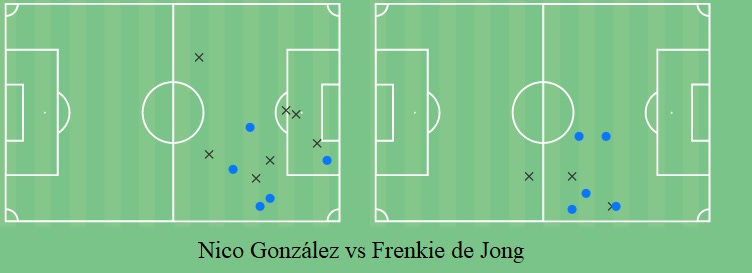
Above are both players’ offensive duels and, just like the heatmaps, they tell us a lot about their roles. Nico receives the ball in the right half-space and from there, he does his best work. Additionally, as we’ve alluded to before, his final third and box presence is simply much more impactful.
It’s quite ironic that Koeman has spent so long looking for physical midfielders with such a profile in the market while there was a perfect one right in front of his nose. Another very important thing to note here is that De Jong records far more deep offensive duels as his role tasks him to advance play and beat pressure with his progressive runs. Nico can do that as well, which we’ll see shortly too, but is generally more of a natural interior than Frenkie.
Whenever Barcelona play with De Jong and Sergio Busquets, it feels like they have a double pivot or a pivot and a midfielder who’s trying to be something between a ‘6’ and an ‘8’. Unfortunately, while it can reinforce the first phase of the build-up play, it robs Barcelona of a more penetrative and aggressive presence higher up. The following image shows us a very simple and yet crucial aspect of Nico’s role.
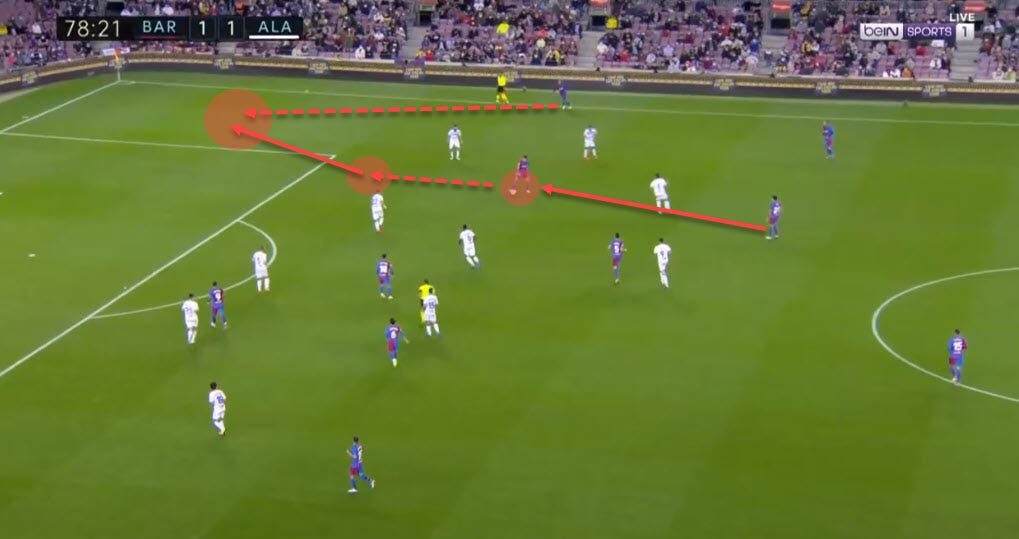
Notice the pocket of space Nico is occupying here. This is exactly what a Barcelona interior should be able (and tasked) to do - receiving in the half-space, turning with a single touch, advancing with the ball and then combining higher up the pitch. It seems like a very simple sequence and essentially, it is exactly that. But it’s also highly effective and sadly, something we don’t get from De Jong.
Again, it’s not so much that De Jong can’t do this. He most definitely can. But the issue is that he's not exactly trying (or tasked) to. Instead, we see him drop far too deep and drift far too wide to have a bigger impact on the team’s attacks. Sometimes, it may be beneficial when Barcelona are pressed high or need cover on the flanks but this role is far too limiting for the Dutchman.
We’ve seen the same thing against Real Madrid too. Barcelona lacked a clear plan of attack, as explained in our tactical analysis of El Clásico, and the midfield, in particular, felt redundant.
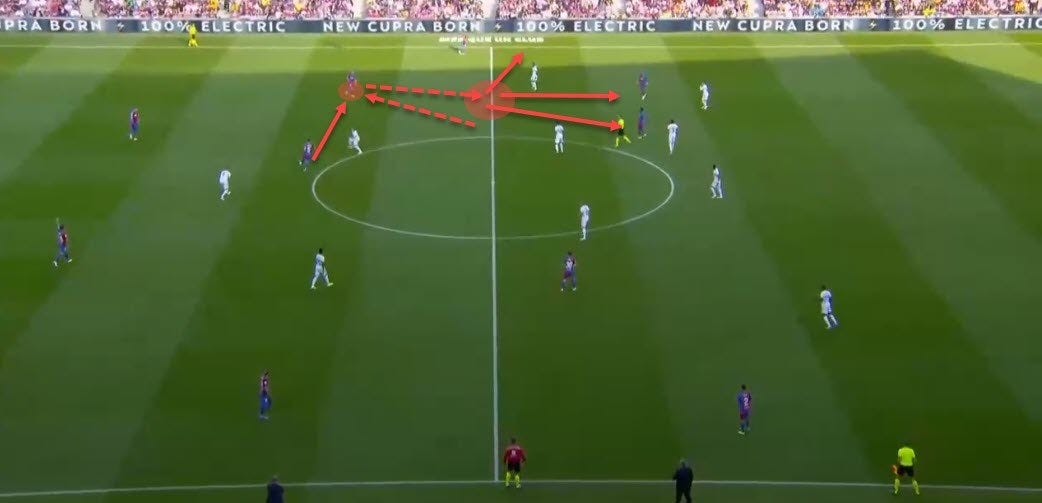
De Jong was sadly at the core of that issue. His presence was largely underwhelming simply due to the fact he was reduced to a very unimpactful role. Yes, his connection with key figures like Memphis Depay, Alba or Ansu Fati made an illusion of something bigger but at the end of the day, his only meaningful task was link-up from deep. And for that, Barcelona have Busquets, making De Jong’s inclusion in the equation questionable.
Of course, the other side of the coin is equally worrying. At times, De Jong is asked to do far too much, once again making the specifics of his role quite unclear. Is he a deep-lying playmaker, a defensive midfielder, a box-to-box midfielder or maybe something entirely different? At the moment, I’m not even sure we can answer that question with complete confidence.
Contrast that to what the Catalans get from Nico’s presence and the difference is as clear as day.
The Barcelona interior
So now that we’ve established some of the core differences between the two midfielders, let’s touch upon Nico’s role a bit more. We know he receives the ball in different areas than De Jong and is then far more penetrative and dangerous moving forward. At the same time, he does share some responsibilities with the Dutchman, such as dropping deeper when necessary and forming a double pivot with Busquets.
But despite this illusion of the same profile/role, Nico does core things differently. Take his passing, for example. Below you can see their recent passmaps where they both had a decent sample to analyse.
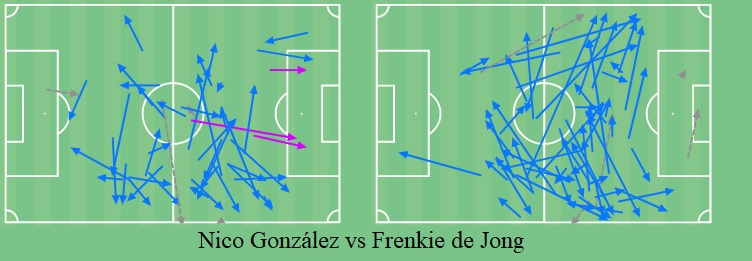
Frenkie is clearly the one far more involved in most cases; a key recycler of possession and a key presence on the ball. But even with that being said, Nico is the one who seems more venturous as of late. I’ve criticised the LaMasia youngster in one of my threads for being too conservative of a passer. Interestingly, that seems to be changing for the better.
Not only is he more courageous on the ball but is also actively looking for opportunities to break lines, advance play and progress into the danger areas. Note, however, that this was always a part of his profile, which you can read in the thread below, but was something that needed to be shown far more often than it was.
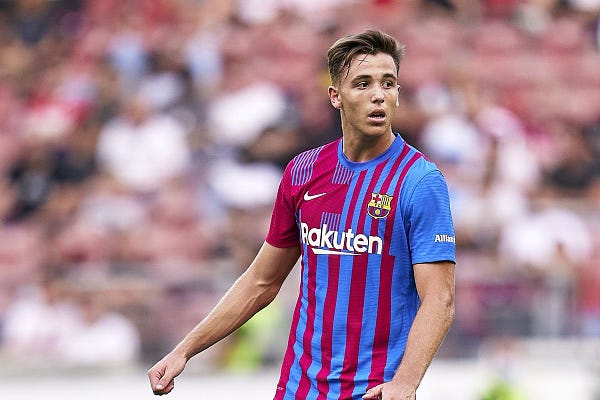
Now, he is developing into a more creative and progressive passer as a whole. Yes, the passmap still looks relatively risk-free but with an increase in pass length and especially in the quantity (and quality) of key passes. That in itself is crucial for both his development and the team’s fortunes.
Let’s look at how that’s already benefiting Barcelona’s attacking phase in particular. We know De Jong can receive deep and then drive with the ball. After all, that’s one of his specialities. But the issue is that he’s not following it up with direct threat or lethal passing.
Nico, on the other hand, is starting to fully develop that box-to-box profile Barcelona are in dire need of.
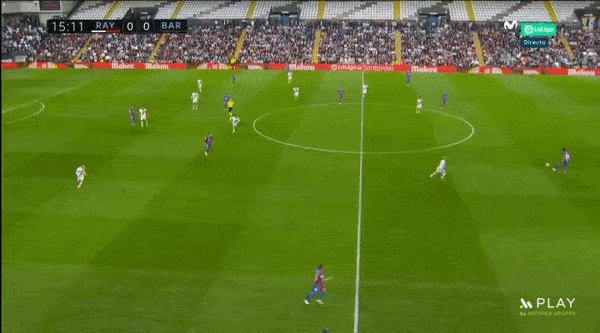
Notice in the GIF above how he drops deep to assist the build-up, just like De Jong, and then after beating his marker elegantly, he advances up the pitch with pace before deploying a piercing through ball to Depay.
This is exactly the kind of verticality, threat and proactivity Barcelona need from their interiors. Sadly, again, it’s something De Jong hasn’t been able to replicate so far. This becomes even more impressive when we factor in Nico’s physicality, which is something that usually immediately excludes technique and agility.
Not in Nico’s case though. He combines two contrasting traits perfectly and it makes for a very unique profile that gives Barcelona the best of both worlds. That’s perfectly visible in the following GIF.
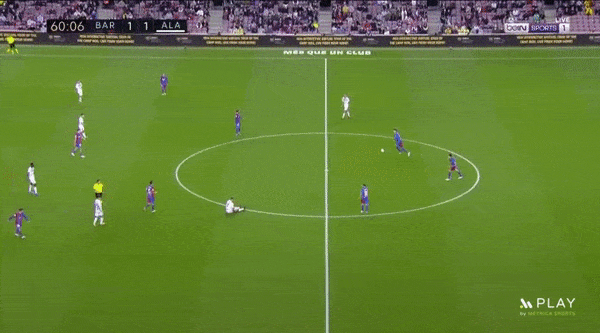
Firstly, notice how Nico scans before receiving the ball. That’s extremely important and an essential trait of all LaMasia graduates. Secondly, his first instinct is to attack space with pace and power, shrugging off two markers before deploying a nicely lobbed pass into Memphis once again.
Imagine if the likes of Paulinho or Arturo Vidal had the technical quality of a LaMasia graduate and you essentially get Nico González. He’s big, fast and strong while also having great control, awareness and technicality of diminutive and agile midfielders. And if the importance (and success) of the aforementioned duo is anything to go by, Nico’s future seems bright, to say the least.
Barcelona generally always have two types of midfielders occupying their interior positions. One, usually the left one, is more creative and enjoys a freer role. The other, usually the right one, is more of a box-to-box presence that combines physicality and technique very well. Nico seems to perfectly fit the latter role, far more so than De Jong does at the moment.
That doesn’t mean there’s no place for De Jong in the squad. Even though he’s been shaky in the single-pivot position, he does seem to have all the characteristics of a good deep-lying midfielder who could eventually replace Busquets. Yes, that role might limit him at first but with Nico on the pitch at the same time, Frenkie would be free to roam and advance from deep since Nico would be there to cover and drop for him when necessary.
Such a relationship would theoretically create a different (and arguably better) dynamic from the one Frenkie and Busquets have at the moment where both are too deep for their own good. Not to mention that having a clearly defined role is the best solution for De Jong’s current problems.
Maybe something for Xavi Hernández to think about upon taking over the first team, hopefully sooner rather than later.


